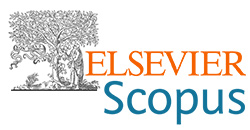Investigations of nanomaterial-based membranes for efficient removal of contaminants from wastewater via membrane distillation: a critical review
DOI:
https://doi.org/10.62638/ZasMat1077Abstract
The requirement for wastewater treatment is paramount in ensuring environmental sustainability and safeguarding public health. As industrialization and urbanization accelerate, the volume of wastewater generated continues to increase, containing a diverse range of pollutants and contaminants. Untreated wastewater poses serious threats to ecosystems, water bodies, and human communities, leading to pollution, waterborne diseases, and ecological imbalances. Effective wastewater treatment becomes essential to mitigate these adverse effects by removing or reducing pollutants before discharge into natural water sources. This process helps to preserve water quality, protect aquatic life, and maintain the overall health of ecosystems. Membrane distillation (MD) has emerged as a promising technology for wastewater treatment, offering an innovative approach to address the challenges associated with conventional treatment methods. In MD, a hydrophobic membrane serves as a selective barrier, allowing water vapor to pass through while preventing the passage of contaminants. This paper offers an extensive overview of the latest advancements in nanotechnology and membrane distillation applied in wastewater treatment. We will delve into different types of nanomaterials that have been used to enhance the properties of MD membranes, such as nanocomposites, nanoparticles, and nanofiber membranes. We also explore the mechanisms by which these nanomaterials improve the separation efficiency, anti-fouling properties, and durability of MD membranes. Additionally, we highlight the potential of hybrid membranes that combine different types of nanomaterials for further improving the performance of MD in wastewater treatment. We provide examples of recent studies that have investigated the use of hybrid membranes, including carbon nanotube-graphene oxide hybrid membranes, nanocomposite nanofiber membranes, and silver nanoparticle-embedded membranes. We also identify some areas for future research and development, such as the scale-up and commercialization of nanotechnology-based MD systems. In summary, this review paper highlights the potential of nanotechnology to enhance the performance of MD in wastewater treatment, leading to improved water quality and a cleaner environment.
Keywords:
Nanocomposite; Nanofibers; Wastewater treatment; Membrane DistillationReferences
Jain, K., Patel, A. S., Pardhi, V. P., & Flora, S. J. S. (2021). Nanotechnology in wastewater management: a new paradigm towards wastewater treatment. Molecules, 26(6), 1797. https://doi.org/10.3390/molecules26061797
Cheriyamundath, S., & Vavilala, S. L. (2021). Nanotechnology‐based wastewater treatment. Water and Environment Journal, 35(1), 123-132.https://doi.org/10.1111/wej.12610
Radjenović, J., Petrović, M., Ventura, F., & Barceló, D. (2008). Rejection of pharmaceuticals in nanofiltration and reverse osmosis membrane drinking water treatment. Water research, 42(14), 3601-3610. https://doi.org/10.1016/j.watres.2008.05.020
Nataraj, S. K., Hosamani, K. M., & Aminabhavi, T. M. (2006). Distillery wastewater treatment by the membrane-based nanofiltration and reverse osmosis processes. Water Research, 40(12), 2349-2356. https://doi.org/10.1016/j.watres.2006.04.022
Madhura, L., Singh, S., Kanchi, S., Sabela, M., Bisetty, K., & Inamuddin. (2019). Nanotechnology-based water quality management for wastewater treatment. Environmental Chemistry Letters, 17, 65-121. https://doi.org/10.1007/s10311-018-0778-8
Kyzas, G. Z., Deliyanni, E. A., & Matis, K. A. (2014). Graphene oxide and its application as an adsorbent for wastewater treatment. Journal of Chemical Technology & Biotechnology, 89(2), 196-205. https://doi.org/10.1002/jctb.4220
Nizamuddin, S., Siddiqui, M. T. H., Mubarak, N. M., Baloch, H. A., Abdullah, E. C., Mazari, S. A., ...& Tanksale, A. (2019). Iron oxide nanomaterials for the removal of heavy metals and dyes from wastewater. Nanoscale materials in water purification, 447-472. https://doi.org/10.1016/B978-0-12-813926-4.00023-9
Tahir, M. B., Sohaib, M., Sagir, M., & Rafique, M. (2022). Role of nanotechnology in photocatalysis. Encyclopedia of smart materials, 578. https://doi.org/10.1016/B978-0-12-815732-9.00006-1
Sakr, M., Mohamed, M. M., Maraqa, M. A., Hamouda, M. A., Hassan, A. A., Ali, J., & Jung, J. (2022). A critical review of the recent developments in micro–nano bubbles applications for domestic and industrial wastewater treatment. Alexandria Engineering Journal, 61(8), 6591-6612. https://doi.org/10.1016/j.aej.2021.11.041
Deshmukh, A., Boo, C., Karanikola, V., Lin, S., Straub, A. P., Tong, T., ... & Elimelech, M. (2018). Membrane distillation at the water-energy nexus: limits, opportunities, and challenges. Energy & Environmental Science, 11(5), 1177-1196. https://doi.org/10.1039/C8EE00291F
Behroozi, A. H., Al-Shaeli, M., & Vatanpour, V. (2023). Fabrication and modification of nanofiltration membranes by solution electrospinning technique: A review of influential factors and applications in water treatment. Desalination, 116638. https://doi.org/10.1016/j.desal.2023.116638
Ammar A, Al-Enizi AM, AlMaadeed MA, Karim A. Influence of graphene oxide on mechanical, morphological, barrier, and electrical properties of polymer membranes. Arabian journal of chemistry. 2016 Mar 1;9(2):274-86. https://doi.org/10.1016/j.arabjc.2015.07.006
Jhaveri, J. H., & Murthy, Z. V. P. (2016). A comprehensive review on anti-fouling nanocomposite membranes for pressure driven membrane separation processes. Desalination, 379, 137-154. https://doi.org/10.1016/j.desal.2015.11.009
Chadha, U., Selvaraj, S. K., Thanu, S. V., Cholapadath, V., Abraham, A. M., Manoharan, M., & Paramsivam, V. (2022). A review of the function of using carbon nanomaterials in membrane filtration for contaminant removal from wastewater. Materials Research Express, 9(1), 012003. DOI 10.1088/2053-1591/ac48b8
Khraisheh, M., Elhenawy, S., AlMomani, F., Al-Ghouti, M., Hassan, M. K., & Hameed, B. H. (2021). Recent progress on nanomaterial-based membranes for water treatment. Membranes, 11(12), 995. https://doi.org/10.3390/membranes11120995
Nthunya, L. N., Gutierrez, L., Khumalo, N., Derese, S., Mamba, B. B., Verliefde, A. R., & Mhlanga, S. D. (2019). Superhydrophobic PVDF nanofibre membranes coated with an organic fouling resistant hydrophilic active layer for direct-contact membrane distillation. Colloids and Surfaces A: Physicochemical and Engineering Aspects, 575, 363-372. https://doi.org/10.1016/j.colsurfa.2019.05.031
Zhang, J., Wang, Z., Zhang, X., Zheng, X., & Wu, Z. (2015). Enhanced antifouling behaviours of polyvinylidene fluoride membrane modified through blending with nano-TiO2/polyethylene glycol mixture. Applied Surface Science, 345, 418-427. https://doi.org/10.1016/j.apsusc.2015.03.193
Alkhouzaam A, Qiblawey H. Functional GO-based membranes for water treatment and desalination: Fabrication methods, performance and advantages. A review. Chemosphere. 2021 Jul 1; 274:129853. https://doi.org/10.1016/j.chemosphere.2021.129853
Sangeetha, V., & Kaleekkal, N. J. (2022). Investigation of the performance of dual-layered omniphobic electrospun nanofibrous membranes for direct contact membrane distillation. Journal of Environmental Chemical Engineering, 10(6), 108661. https://doi.org/10.1016/j.jece.2022.108661
Ju, J., Fejjari, K., Cheng, Y., Liu, M., Li, Z., Kang, W., & Liao, Y. (2020). Engineering hierarchically structured superhydrophobic PTFE/POSS nanofibrous membranes for membrane distillation. Desalination, 486, 114481. https://doi.org/10.1016/j.desal.2020.114481
Attia, H., Alexander, S., Wright, C. J., & Hilal, N. (2017). Superhydrophobic electrospun membrane for heavy metals removal by air gap membrane distillation (AGMD). Desalination, 420, 318-329. https://doi.org/10.1016/j.desal.2017.07.022
Cui, J., Li, F., Wang, Y., Zhang, Q., Ma, W., & Huang, C. (2020). Electrospun nanofiber membranes for wastewater treatment applications. Separation and Purification Technology, 250, 117116. https://doi.org/10.1016/j.seppur.2020.117116
Shaban, M., AbdAllah, H., Said, L., Hamdy, H. S., & Khalek, A. A. (2015). Titanium dioxide nanotubes embedded mixed matrix PES membranes characterization and membrane performance. Chemical Engineering Research and Design, 95, 307-316. https://doi.org/10.1016/j.cherd.2014.11.008
Kim, J., Yun, E. T., Tijing, L., Shon, H. K., & Hong, S. (2022). Mitigation of fouling and wetting in membrane distillation by electrical repulsion using a multi-layered single-wall carbon nanotube/polyvinylidene fluoride membrane. Journal of Membrane Science, 653, 120519. https://doi.org/10.1016/j.memsci.2022.120519
Thomas, N., Kumar, M., Palmisano, G., Al-Rub, R. K. A., Alnuaimi, R. Y., Alhseinat, E., ... & Arafat, H. A. (2021). Antiscaling 3D printed feed spacers via facile nanoparticle coating for membrane distillation. Water Research, 189, 116649. https://doi.org/10.1016/j.watres.2020.116649
Teoh, G. H., Jawad, Z. A., Ooi, B. S., & Low, S. C. (2022). Simultaneous water reclamation and nutrient recovery of aquaculture wastewater using membrane distillation. Journal of Water Process Engineering, 46, 102573.https://doi.org/10.1016/j.jwpe.2022.102573
Bodzek, M., Konieczny, K., & Kwiecińska-Mydlak, A. (2020). Nanotechnology in water and wastewater treatment. Graphene–the nanomaterial for next generation of semipermeable membranes. Critical reviews in environmental science and technology, 50(15), 1515-1579.https://doi.org/10.1080/10643389.2019.1664258
Kim, Y., Suhr, J., Seo, H. W., Sun, H., Kim, S., Park, I. K., ... & Nam, J. D. (2017). All biomass and UV protective composite composed of compatibilized lignin and poly (lactic-acid). Scientific Reports, 7(1), 43596. https://doi.org/10.1038/srep43596
Ardeshiri, F., Salehi, S., Peyravi, M., Jahanshahi, M., Amiri, A., & Rad, A. S. (2018). PVDF membrane assisted by modified hydrophobic ZnO nanoparticle for membrane distillation. Asia‐Pacific Journal of Chemical Engineering, 13(3), e2196. https://doi.org/10.1002/apj.2196
Nthunya, L. N., Gutierrez, L., Verliefde, A. R., & Mhlanga, S. D. (2019). Enhanced flux in direct contact membrane distillation using superhydrophobic PVDF nanofibre membranes embedded with organically modified SiO2 nanoparticles. Journal of Chemical Technology & Biotechnology, 94(9), 2826-2837.
https://doi.org/10.1002/jctb.6104
Tan, H. F., Tan, W. L., Hamzah, N., Ng, M. H. K., Ooi, B. S., & Leo, C. P. (2020). Membrane distillation crystallization using PVDF membrane incorporated with TiO2 nanoparticles and nanocellulose. Water Supply, 20(5), 1629-1642. https://doi.org/10.2166/ws.2020.068
Chimanlal, I., Nthunya, L. N., Mahlangu, O. T., Kirkebæk, B., Ali, A., Quist-Jensen, C. A., & Richards, H. (2023). Nanoparticle-enhanced PVDF flat-sheet membranes for seawater desalination in direct contact membrane distillation. Membranes, 13(3), 317. https://doi.org/10.3390/membranes13030317
Ju, J., Fejjari, K., Cheng, Y., Liu, M., Li, Z., Kang, W., & Liao, Y. (2020). Engineering hierarchically structured superhydrophobic PTFE/POSS nanofibrous membranes for membrane distillation. Desalination, 486, 114481. https://doi.org/10.1016/j.desal.2020.114481
Ju, J., Fejjari, K., Cheng, Y., Liu, M., Li, Z., Kang, W., & Liao, Y. (2020). Engineering hierarchically structured superhydrophobic PTFE/POSS nanofibrous membranes for membrane distillation. Desalination, 486, 114481. https://doi.org/10.1016/j.desal.2020.114481
Huang, R., Liu, Z., Woo, Y. C., Luo, W., Gray, S. R., & Xie, M. (2020). Emerging investigator series: engineering membrane distillation with nanofabrication: design, performance and mechanisms. Environmental Science: Water Research & Technology, 6(7), 1786-1793. DOI: 10.1039/D0EW00100G
Francis, L., & Hilal, N. (2023). Electrohydrodynamic atomization of CNT on PTFE membrane for scaling resistant membranes in membrane distillation. NPJ Clean Water, 6(1), 15.https://doi.org/10.1038/s41545-023-00229
Hou, D., Wang, Z., Wang, K., Wang, J., & Lin, S. (2018). Composite membrane with electrospun multiscale-textured surface for robust oil-fouling resistance in membrane distillation. Journal of Membrane Science, 546, 179-187. https://doi.org/10.1016/j.memsci.2017.10.017
El-Marghany, M. R., El-Shazly, A. H., Salem, M. S. A., Sabry, M. N., & Nady, N. (2019). Novel membrane suitable for membrane distillation: Effect of mixed nanofillers on the membrane performance. Key Engineering Materials, 801, 325-330.
https://doi.org/10.4028/www.scientific.net/KEM.801.325
Zhao, L., Wu, C., Lu, X., Ng, D., Truong, Y. B., & Xie, Z. (2018). Activated carbon enhanced hydrophobic/hydrophilic dual-layer nanofiber composite membranes for high-performance direct contact membrane distillation. Desalination, 446, 59-69. https://doi.org/10.1016/j.desal.2018.09.002
Lee, E. J., An, A. K., Hadi, P., Lee, S., Woo, Y. C., & Shon, H. K. (2017). Advanced multi-nozzle electrospun functionalized titanium dioxide/polyvinylidene fluoride-co-hexafluoropropylene(TiO2/PVDF-HFP) composite membranes for direct contact membrane distillation. Journal of Membrane Science, 524, 712-720.
https://doi.org/10.1016/j.memsci.2016.11.069
Makanjuola, O., Anis, S. F., & Hashaikeh, R. (2021). Enhancing DCMD vapor flux of PVDF-HFP membrane with hydrophilic silica fibers. Separation and Purification Technology, 263, 118361. https://doi.org/10.1016/j.seppur.2021.118361
Francis, L., & Hilal, N. (2022). Electrosprayed CNTs on electrospun PVDF-Co-HFP membrane for robust membrane distillation. Nanomaterials, 12(23), 4331. https://doi.org/10.3390/nano12234331







